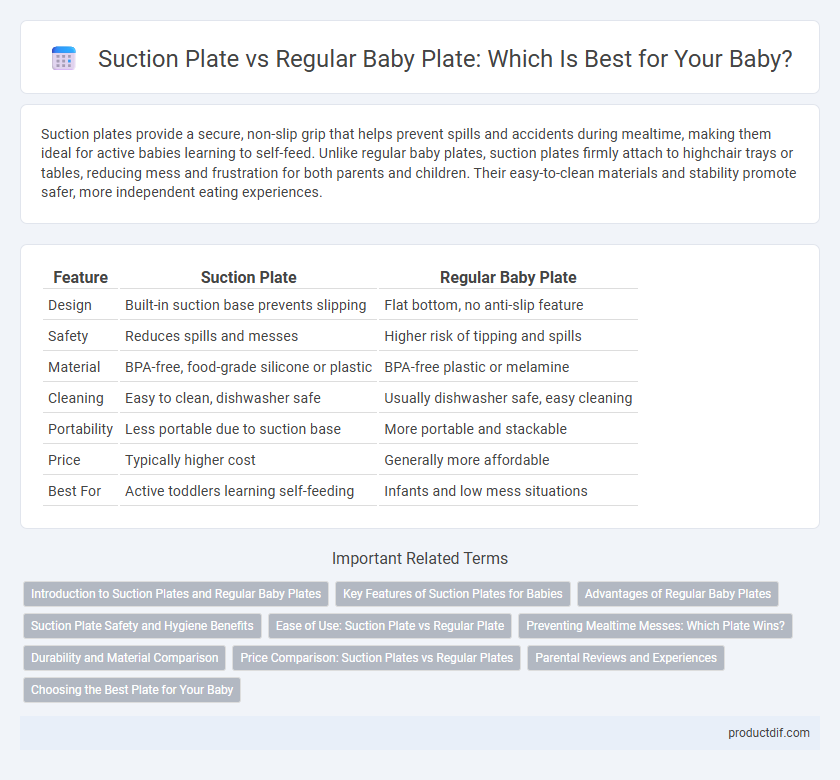Suction plates provide a secure, non-slip grip that helps prevent spills and accidents during mealtime, making them ideal for active babies learning to self-feed. Unlike regular baby plates, suction plates firmly attach to highchair trays or tables, reducing mess and frustration for both parents and children. Their easy-to-clean materials and stability promote safer, more independent eating experiences.
Table of Comparison
| Feature | Suction Plate | Regular Baby Plate |
|---|---|---|
| Design | Built-in suction base prevents slipping | Flat bottom, no anti-slip feature |
| Safety | Reduces spills and messes | Higher risk of tipping and spills |
| Material | BPA-free, food-grade silicone or plastic | BPA-free plastic or melamine |
| Cleaning | Easy to clean, dishwasher safe | Usually dishwasher safe, easy cleaning |
| Portability | Less portable due to suction base | More portable and stackable |
| Price | Typically higher cost | Generally more affordable |
| Best For | Active toddlers learning self-feeding | Infants and low mess situations |
Introduction to Suction Plates and Regular Baby Plates
Suction plates feature a silicone base that firmly adheres to highchair trays or tables, preventing spills and reducing mess during mealtime. Regular baby plates, typically made of plastic or melamine, lack this suction mechanism, making them prone to tipping and sliding, which can lead to frequent cleanup. Choosing suction plates enhances stability and encourages independent eating for infants and toddlers.
Key Features of Suction Plates for Babies
Suction plates for babies feature a strong silicone base that securely attaches to highchair trays, preventing spills and messes during mealtime. These plates often include divided sections to keep foods separate, promoting easy self-feeding and portion control. Made from BPA-free, non-toxic materials, suction plates ensure safety while offering convenience and stability compared to regular baby plates.
Advantages of Regular Baby Plates
Regular baby plates offer versatility in design and materials, often available in a variety of shapes, sizes, and colors that can engage a child's interest during mealtime. They typically require less maintenance and can be easily stacked or stored, making them a practical choice for busy parents. Unlike suction plates, regular baby plates do not rely on a surface attachment, allowing for easier cleaning and use in diverse eating environments.
Suction Plate Safety and Hygiene Benefits
Suction plates offer significant safety benefits by firmly adhering to surfaces, preventing spills and reducing choking hazards during mealtime for babies. Their secure attachment minimizes the risk of contamination by keeping the plate stable and off potentially dirty floors, enhancing overall hygiene. Unlike regular baby plates, suction plates are designed to withstand vigorous use while maintaining a clean and safe eating environment.
Ease of Use: Suction Plate vs Regular Plate
Suction plates offer superior ease of use by securely attaching to highchair trays or tables, preventing spills and reducing mess during mealtime. Unlike regular baby plates, suction plates stay firmly in place, minimizing the need for constant supervision and plate adjustments. This hands-free stability enhances feeding convenience for caregivers and promotes independent eating for babies.
Preventing Mealtime Messes: Which Plate Wins?
Suction plates outperform regular baby plates in preventing mealtime messes by securely attaching to highchair trays or tables, reducing spills and plate tipping. Their strong, non-slip base ensures stability during feeding, minimizing food waste and cleaning time for parents. Regular baby plates lack this adhesion feature, often leading to more frequent accidents and messes.
Durability and Material Comparison
Suction plates for babies typically feature BPA-free silicone or sturdy plastic materials designed to withstand frequent use and resist breaking better than regular baby plates made from thinner plastic or melamine. The suction mechanism enhances durability by securing the plate firmly to surfaces, reducing the risk of drops and spills that can cause cracks or chips. Regular baby plates may be more prone to wear and tear, while suction plates provide longer-lasting performance and safer meal times for infants.
Price Comparison: Suction Plates vs Regular Plates
Suction plates generally cost between $8 and $15, reflecting their added functionality for preventing spills compared to regular baby plates priced around $5 to $10. The investment in suction plates offers better value by reducing messes and enhancing mealtime convenience despite a slightly higher price point. Parents often find the price difference justified by the durability and stability provided by suction plates over regular options.
Parental Reviews and Experiences
Parents favor suction plates for their ability to securely anchor on highchair trays, minimizing spills and messes during mealtime. Many reviews highlight the ease of cleaning and durability of suction plates compared to regular baby plates, which tend to slide and require frequent repositioning. Experiences also reveal that suction plates reduce mealtime stress, allowing both toddlers and caregivers to focus on eating rather than dish management.
Choosing the Best Plate for Your Baby
Suction plates secure firmly to surfaces, preventing spills and promoting independent eating, making them ideal for toddlers prone to tossing their plates. Regular baby plates offer versatility and ease of cleaning but may require constant monitoring to avoid messes. Selecting the best plate depends on your baby's age, eating habits, and the need for stability during mealtime.
Suction Plate vs Regular Baby Plate Infographic

 productdif.com
productdif.com